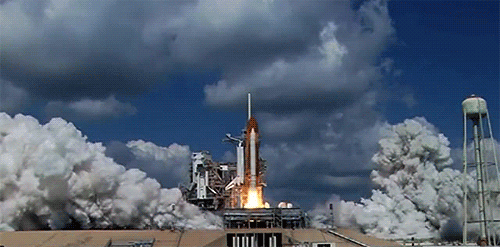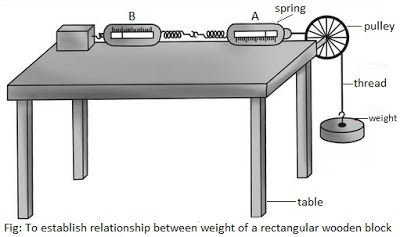1) Force :-
Force is an external effort which may
move a body at rest or stop a moving body or change the speed of a moving body
or change the direction of a moving body or change the shape and size of a body.
Effects of force :-
i) Force can move a body at rest.
ii) Force can stop a moving body.
iii) Force can
change the speed of a moving body.
iv) Force can
change the direction of a moving body.
v) Force can
change the shape and size of a body.
2) Balanced and unbalanced forces :-
i) Balanced forces :-
If two forces
act on a body in opposite direction and if both the forces are equal, then the
resultant force acting on the body is zero. Such forces are called balanced
forces.
ii) Unbalanced
forces :-
If
two forces act on a body in opposite direction and if one force is greater than
the other, then the resultant force is not equal to zero. Such forces are
called unbalanced forces.
Unbalanced forces changes the state of rest or the motion of a body.
3) Force of friction :-
Force of friction is the force which
opposes the motion of an object over a surface.
Eg :- A ball rolling on ground gradually
slows down and comes to a stop due to
force of friction. If we stop pedalling a
bicycle, it gradually slows down
and comes to a stop due to force of friction.
An object with uniform motion will continue to move with uniform motion if the forces acting on it ( pushing force and frictional force ) are balanced.
If an unbalanced force acts on the moving
body, then its speed or direction of motion changes.
If the unbalanced force is removed, then it
will continue to move with the speed it had acquired till then.
4) Galileo’s experiment of motion of an object on
an inclined plane :-
When a marble rolls down an inclined
plane, its velocity increases and when it goes up on the second inclined plane,
its velocity decreases. If the inclinations of both the planes are equal, then the
marble will reach the same height which it rolled down. If the inclination of
the second plane is decreased, it will travel more distance to reach the
original height. If the inclination of the second plane is made horizontal, the
marble will travel forever trying to reach the same height. An unbalanced force
is required to change the motion of the marble but no force is needed to
sustain the uniform motion of the marble.
WATCH VIDEOS: [HINDI] [ ENGLISH ]
WATCH VIDEOS: [HINDI] [ ENGLISH ]
5) Newton’s laws of motion :-
Newton’s
first law of motion states that :- ‘An object remains in a state of rest
or in uniform motion in a straight line unless compelled to change that state
by an applied force.’
Watch Video: [ Newton's First Law ]
Watch Video: [ Newton's First Law ]
Inertia :- The
natural tendency of objects to remain in a state of rest or in uniform motion
is called inertia.
Examples of
inertia :-
i) If a striker hits a pile of coins
on a carom board, the lowest coin moves
out and due to inertia of rest, the other coins fall down.
ii) If a coin placed on a playing
card over a tumbler is flicked with the finger, due to inertia of rest, the
coin falls down into the tumbler.
iii) When we travel in a car and the
driver applies the brakes suddenly, we tend to fall forward due to inertia of
motion.
iv) When we are standing in a bus
and the bus begins to move suddenly, we tend to fall backward because our feet
in contact with the floor moves forward but the upper part of the body
continues to remain at rest due to inertia of rest.
6) Inertia and Mass :-
A body at rest continues to be at rest
and a body in motion continues to be in motion. This property of a body is
called its inertia.
The inertia of a body is
measured by the magnitude of force required to change the state of the body. The
force required to change the state of a heavier
body is more than the force required to change the state of the lighter
body. This is because the mass of the heavier body is more than the mass of the
lighter body.
So ‘The mass of a body is a measure
of its inertia.’
 |
| (Breaking Inertia of Rest) |
7) Momentum of a body :-
The momentum of a body is the product of its mass and
velocity.
Momentum = mass x velocity
p = mv where p is the momentum of a body
m is the mass of the body
v
is the velocity of the body
If a
body is at rest its velocity is zero and so its momentum is also zero.
The SI
unit of momentum is kilogram metre per second or kg m/s or kg ms-1
Eg :- A truck moving at a very low speed can kill a
person standing in its path because of the heavy mass of the truck.
A bullet of small mass when fired from
a gun can kill a person because of the large velocity of the bullet.
8) Newton’s second law of
motion :-
Newton’s second law of motion states
that :- ‘ The rate of change of momentum of an object is
proportional to the applied force in the direction of force.’
Mathematical formulation of Second law of
motion :-
If an
object of mass m is moving along a straight line with initial velocity u and is
accelerated to velocity v in time t by applying a force F, then
Initial momentum p1 = mu
Final momentum p2 = mv
Change in momentum p2 – p1
= mv – mu
= m (v – u )
Rate of change of momentum = m (v – u )
t
Or
the applied force F α m (v – u ) or
F = k m (v – u ) but
(v – u ) = a
t t t
So F = k ma
where k is a constant of proportionality
Or F = ma
The SI unit of mass is kg and acceleration is m/s2
or ms-2 so the unit of Force is kg ms-2 or Newton. It’s symbol is N
[ video explaining second law of Motion]
[ EXPLAINING FIRST EQUATION ]
[ EXPLAINING SECOND EQUATION ]
[ EXPLAINING THIRD EQUATION ]
IMPROVE YOUR PHYSICS FUNDAMENTALS HERE: (click videos below)
(A) [ EQUATIONS OF MOTION ]
(B) [ ACCELERATION ]
(C) [ VELOCITY ]
(D) [ DISTANCE & DISPLACEMENT ]
(E) [ SCALAR & VECTOR QUANTITIES ]
[ video explaining second law of Motion]
[ EXPLAINING FIRST EQUATION ]
[ EXPLAINING SECOND EQUATION ]
[ EXPLAINING THIRD EQUATION ]
IMPROVE YOUR PHYSICS FUNDAMENTALS HERE: (click videos below)
(A) [ EQUATIONS OF MOTION ]
(B) [ ACCELERATION ]
(C) [ VELOCITY ]
(D) [ DISTANCE & DISPLACEMENT ]
(E) [ SCALAR & VECTOR QUANTITIES ]
10) Newton’s third law of motion :-
Newton’s third law of motion states that :- ‘To every action
there is an equal and opposite reaction and they act on two different bodies.’
Take
two spring balances A and B connected together. Fix the spring balance B to a
rigid support. When a force is applied by pulling the free end of the spring
balance A, both the spring balances show the same readings. This shows that the
force exerted by the spring balance A on B is equal but opposite in direction
to the force exerted by spring balance B on A . The force exerted by the spring
balance A on B is action and the force exerted by the spring balance B on A is
reaction.
Examples of
action and reaction :-
i) When a bullet
is fired from a gun, it exerts a forward force (action) on the bullet and the
bullet exerts an equal and opposite force on the gun (reaction) and the gun
recoils.
 |
| (courtesy giphy.com) |
iii) When an air
filled balloon is released, the force of the air coming out of the balloon (action) exerts an equal and
opposite force on the balloon (reaction) and it moves upward.
iv) When a rocket
is fired, the force of the burning gases coming out (action) exerts an equal
and opposite force on the rocket (reaction) and it moves upward.

11) Conservation of momentum :-


The Law of
conservation of momentum states that :-
‘The sum of momenta of two objects before collision is equal to the
sum of momenta after collision provided there is no unbalanced forces acting on
them.’
This
means that the total momentum of the two objects is unchanged or conserved by
collision.
If two balls A and B of masses mA and mB are
travelling in a straight line with initial velocities uA and uB
and if uA > uB, the two balls will collide with each
other. During collision at a time t, ball A exerts a force FAB on
ball B and ball B exerts a force FBA on ball A. If vA and
vB are the velocities of balls A and B after collision,
The momenta of ball A before and after collision are mAuA and mAvA
and the momenta of ball B before and after collision are mBuB
and mBvB.
Change in momentum of ball A during collision = mAvA
– mAuA
Rate of change of momentum of ball A (FAB)
= mA (vA - uA)
t
Change in momentum of ball B during
collision = mBvB – mBuB
Rate of change of momentum of ball B (FBA
) = mB (vB - uB)
t
According to Newton’s third law of motion the
force FAB exerted by ball A on ball B is equal and
opposite to the force FBA exerted by ball B on ball A.
Therefore
FAB = - FBA
or
mA = (vA - uA) = - mB (vB - uB)
t t
or
mAvA - mAuA = - mBvB + mBuB
or
- mAuA - mAuA
= - mAvA - mBvB
or mAuA + mBuB = mAvA + mBvB
Momentum of the two balls before collision is
equal to the momentum of the two balls after collision.


Courtesy Google and relevant owners for Videos / Pictures/ GIFs











No comments:
Post a Comment